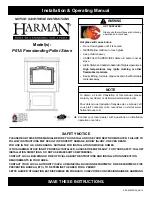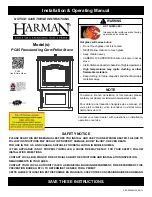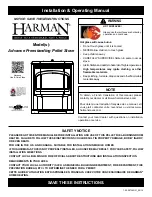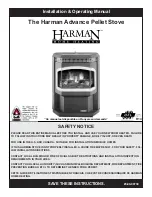
HearthStone
Quality Home Heating Products Inc
®
Tribute Model 8040
19
EXCESSIVE DRAFT: Contact your dealer to
have a draft reading taken. Any draft in excess of 0.1 wc
requires a damper in the stovepipe. Some installations may
require more than one damper.
INAPPROPRIATE FUEL: Do not burn coal, kiln
dried lumber, wax logs or anything other than natural
cordwood.
OPERATOR ERROR: Make sure all the gaskets
are in good condition. Replace worn out or compressed
gaskets. Do not burn the stove with the door in the open
position.
Monitoring the temperature of the surface of the top stones
is the best way to determine if the stove is over-firing. If
you suspect that your stove is over-firing, contact your
dealer immediately.
Damage done by over-firing is not
covered by your warranty
.
Results of over-firing can
include: warped or burned out internal parts, cracked
stones, discolored or warped external parts, and damaged
enamel.
NOTE: ANY SYMPTOMS OF OVER-FIRING
WILL VOID YOUR WARRANTY!!
R
EMOVAL
A
ND
D
ISPOSAL
O
F
A
SHES
Ashes should be removed when the stove is cold. Use
protective fireplace gloves when the pan is warm. Exercise
extreme caution when handling, storing or disposing of
ashes.
The firebox should be cleared of ashes often, and they
should not be allowed to build up more than 3 inches high,
and it is important to prevent ashes from building up around
the dog house.
Ashes should be dumped into a metal container with a tight
fitting lid. Do not place any other items or trash into the
metal container. Replace the lid onto the container and
allow the ashes to cool. Do not place the ash disposal
container on a combustible surface or vinyl flooring, as the
container will be
hot!
Pending disposal, place the closed ash container on a
noncombustible floor or on the ground, well away from all
combustible materials. Ashes should be retained in the
closed container until all cinders have thoroughly cooled.
Ashes should NEVER be placed in wooden or plastic
containers, or in paper or plastic bags, no matter how long
the fire has been out. Coals within a bed of ashes can
remain hot for several days once removed from the firebox.
MAINTENANCE
M
ONITORING
S
TOVE
T
EMPERATURES
Monitor the stove temperatures with a stove thermometer
(available from your dealer) placed on the top center stone
of the stove. The thermometer could read as high as
500
°
F(260
°
C) on High Burn and 200-300
°
F(93-149
°
C) on
low burn. Maintaining temperatures in excess of
600
°
F(316
°
C) will cause the stones to crack and other
damage to the stove.
Do not over-fire the stove.
(refer to page 18).
Damage done by over-firing will void the
warranty.
C
REOSOTE
F
ORMATION
A
ND
N
EED
F
OR
R
EMOVAL
When wood is burned slowly, it produces tar and other
organic vapors, which combine with expelled moisture to
form creosote. These creosote vapors condense in the
relatively cool chimney flue of a slow-burning fire. As a
result, creosote residue accumulates on the flue lining.
When ignited, this creosote makes an extremely hot fire,
which may damage the chimney or even destroy the house.
When burning wood, the chimney connector and chimney
should be inspected at least o nce every two months during
the heating season to determine if a creosote buildup has
occurred.
To prevent the buildup of creosote:
1. Burn the stove with the primary air control
fully open for 35 - 45 minutes daily to burn out creosote
deposits from within the stove and the venting system.
2. After reloading with wood, burn the stove with
the primary air control fully open for 20 to 30 minutes.
This manner of operation ensures early engagement of the
secondary combustion system which, when engaged,
minimizes creosote buildup in the chimney.
The stovepipe connector and chimney should be inspected
at least monthly during the heating season to determine if a
creosote build-up has occurred. If a creosote residue
greater that 1/4" (6 mm) has accumulated, it should be
removed to reduce the risk of a chimney fire.










































